THE DEER, BOARS, AND HUNTERS OF POLAND
By Lee Foote
Lee is a Professor at the University of Alberta
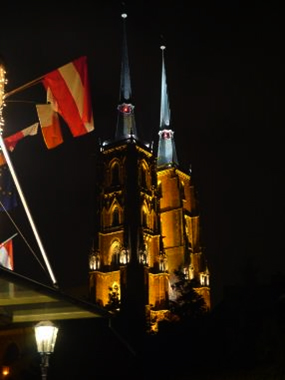 The KLM wheels touched the tarmac at Warsaw, Poland near suppertime and to say my hunting partner Matt "met" me would be an understatement. More like he snatched me up and the whirlwind began. He bundled us into a Taxi—a Diesel BMW 530 of all things—and a hand-waving, rapid-fire discussion in Polish ensued as the driver whisked us across town, while Matt animatedly discussed drinking, women, hotels, and ordered our meal ahead of time. Matt is a Polish-Canadian who happens to be Polish-fluent and has family in Warsaw. He was our "whip" and facilitator, launching into conversations with cabbies, waiters, cooks and saying things that sounded like: “Pushta neim gorchek knee bolk!” They respond by speaking backwards to him as if they understood his gibberish. I'd have thought they were humoring the feebleminded except they tended to hug him, proffer vodka and give helpful directions.
The KLM wheels touched the tarmac at Warsaw, Poland near suppertime and to say my hunting partner Matt "met" me would be an understatement. More like he snatched me up and the whirlwind began. He bundled us into a Taxi—a Diesel BMW 530 of all things—and a hand-waving, rapid-fire discussion in Polish ensued as the driver whisked us across town, while Matt animatedly discussed drinking, women, hotels, and ordered our meal ahead of time. Matt is a Polish-Canadian who happens to be Polish-fluent and has family in Warsaw. He was our "whip" and facilitator, launching into conversations with cabbies, waiters, cooks and saying things that sounded like: “Pushta neim gorchek knee bolk!” They respond by speaking backwards to him as if they understood his gibberish. I'd have thought they were humoring the feebleminded except they tended to hug him, proffer vodka and give helpful directions.
While I was photographing church spires from the hotel parking parapet Matt was hugging the taxi driver. Get used to that: it's Polish. The language here hits my ear with the happy sound of a basket of hockey pucks and two live rattlesnakes being shaken inside an oil drum. My English and Spanish share nothing with this tongue except possibly the snake bites.
Then we were off for my 3rd flight of the day: this time to Wroclaw (formerly Breslau) and to one of the finest hotel in town. We learned that Hitler stayed in this pre-War hotel too, during the occupation of Poland. He was just one floor up from us. A dubious honor I say, but the marble floors, rooms furnished with ancient oak antiques, the 11th to 14th century Cathedrals next door were rich in history.
I don’t fly particularly well, simply because I can’t sleep on planes the previous day had involved a trans-Atlantic flight and two others to get here. Many of the cathedrals had buttressed bases and some flying buttresses. I just had a "flying butt" with 3 flights in 24 hours.
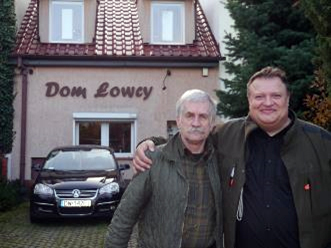
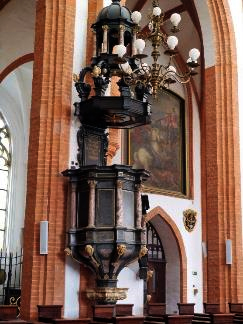 The next morning we walked the historic town for 3 hours, toured cathedrals, and visited a European gun shop situated in a home in the suburbs. Here Matt (on right) had to do some more hugging of the proprietor.
The next morning we walked the historic town for 3 hours, toured cathedrals, and visited a European gun shop situated in a home in the suburbs. Here Matt (on right) had to do some more hugging of the proprietor.
The Persian-themed gardens, laid stone streets and garden solarium gave it an ethereal feel. Our 4-room suite with 3 televisions, two complete baths, and meeting room were welcomed in my travel-weary state, as was the six-course breakfast the next morning in preparation for 6 hours of walking through historic old town.
Matt did some Catholic pew time in a  particularly pretty church with the Black Madonna on display, hopefully is praying for a successful hunt. We thought that when his arch Catholic Italian wife Lucia sees this he may get sent to Poland
particularly pretty church with the Black Madonna on display, hopefully is praying for a successful hunt. We thought that when his arch Catholic Italian wife Lucia sees this he may get sent to Poland 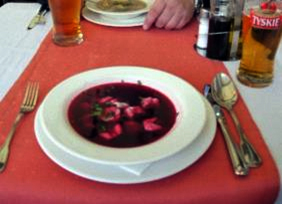 more often. This lectern is named after the elevated hunting stands used in Europe. How appropriate!
more often. This lectern is named after the elevated hunting stands used in Europe. How appropriate!
We sought a place to eat Polish food and found this place that amusingly uses the wild boar symbol to advertise veganism. What the heck? Boars are not vegetarian, much less vegan! Beet soup and a Tyskie lager, yum!
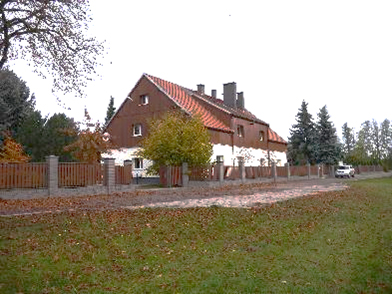
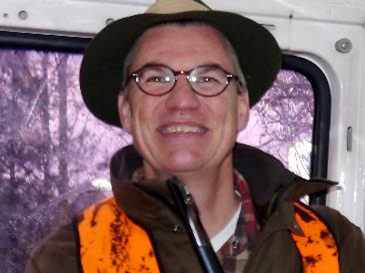 In addition to Matt I had several wise tour guide friends on this trip. German/Canadian forest economist Christian Schadendorf (right) did the majority of the hunt arranging and he and Bernhard met us at sunset, driving us an hour north to a woodland lodge. There we would be based to shoot wild boars among other things. It seems boars are the scourge of the countryside, but more on that later. The name of the place, above left, is Kwatera Mysliwska in Zmigrod, Poland. It is a country-owned facility that leases space out to visiting groups who are hunting. We were one such group. Part of the fee to the Polish government covers a full time translator. In our case, a pretty blonde woman who had a dorm room in the lodge and went into the field with the hunting crew.
In addition to Matt I had several wise tour guide friends on this trip. German/Canadian forest economist Christian Schadendorf (right) did the majority of the hunt arranging and he and Bernhard met us at sunset, driving us an hour north to a woodland lodge. There we would be based to shoot wild boars among other things. It seems boars are the scourge of the countryside, but more on that later. The name of the place, above left, is Kwatera Mysliwska in Zmigrod, Poland. It is a country-owned facility that leases space out to visiting groups who are hunting. We were one such group. Part of the fee to the Polish government covers a full time translator. In our case, a pretty blonde woman who had a dorm room in the lodge and went into the field with the hunting crew.
The firearms required are minimal. The boars and small elkish red deer are the biggest and any thing from a .30-30 or .257 Roberts up would be plenty. There is none of the concern about wounding loss as a costly accident which encourages African hunters to use hugely powerful rifles for normal sized game. Any crippled game will have some spectacular dogs on the animals track and they are simply not lost. This is an animal damage control hunt mostly with the occasional option for a trophy-for-fee.
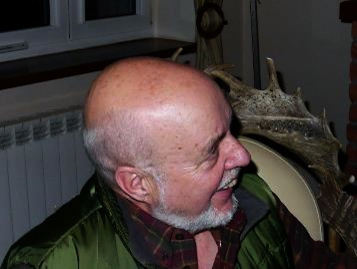 Our hunting party was very euro-centric with dual
Our hunting party was very euro-centric with dual 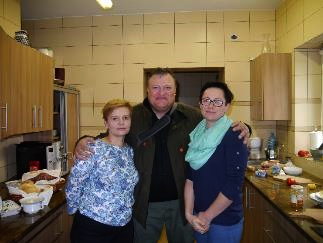 citizens from Polish-American, American-Canadian, German-Canadian, Danish, Polish, German. There were some car rides where hand-signals and pointing were required to communicate. World War III did not break out. While Matt was being friendly with the cook staff, another hunter, Richard “Ricardo” Spilker sat on a throne of antlers. We only belatedly discovered Richard holds a Bachelor of Jurisprudence, hence, should be "Mr. Spilker, LLB" but don’t tell him that or hat sizes may change.
citizens from Polish-American, American-Canadian, German-Canadian, Danish, Polish, German. There were some car rides where hand-signals and pointing were required to communicate. World War III did not break out. While Matt was being friendly with the cook staff, another hunter, Richard “Ricardo” Spilker sat on a throne of antlers. We only belatedly discovered Richard holds a Bachelor of Jurisprudence, hence, should be "Mr. Spilker, LLB" but don’t tell him that or hat sizes may change.
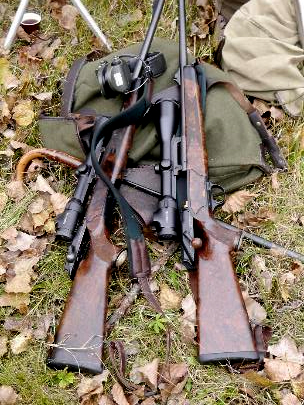
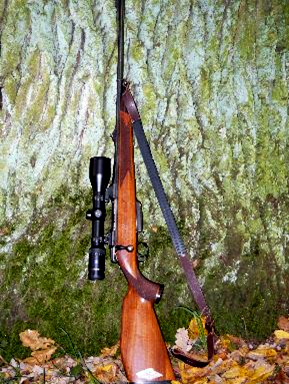 By design we arrived in Poland without rifles, shells or knives, for expediency in various border patrol and customs clearances. It is not trivial to take firearms into Poland but it can be done by someone who follows the rules and files the paperwork. We were lucky to have European friends with good arsenals who provided for us. Both Christian and Bernard have well-stocked gun vaults and had promised to provide for us, which they did with beautiful exotica. A couple of Bernhard’s Blaser rifles had some of the most beautiful wood grain I have ever seen.
There were all sorts of interesting rifles including Christian’s Sauer .30-06 with the slickest bolt action of all time.
By design we arrived in Poland without rifles, shells or knives, for expediency in various border patrol and customs clearances. It is not trivial to take firearms into Poland but it can be done by someone who follows the rules and files the paperwork. We were lucky to have European friends with good arsenals who provided for us. Both Christian and Bernard have well-stocked gun vaults and had promised to provide for us, which they did with beautiful exotica. A couple of Bernhard’s Blaser rifles had some of the most beautiful wood grain I have ever seen.
There were all sorts of interesting rifles including Christian’s Sauer .30-06 with the slickest bolt action of all time.
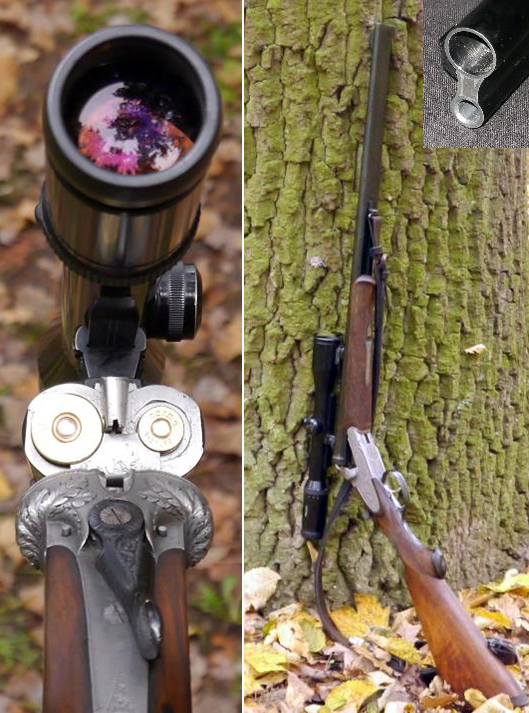 I was handed an interesting double-trigger side by side shotgun rifle combo built by Ferlach and called a “Cape Gun.” Could be a pig and pigeon combo or a slug and rifle. It was a 8x57 rifle and a 16 gauge smoothbore melded into a double-gun. Two triggers, beautiful checkering and fine engraving. I think it would make my gun nut friends a little moist. Whole lotta variables at play here: A gun with two types of ammo, two different trigger pulls, with very different trajectories and leads: roll with it! It was one of the hundreds of thousands of German firearms that were hidden or buried across the country after WWII Armistice required Germany’s populace to be firearm-free. Later unearthed and repaired, it makes a fine hunting piece, except I didn’t shoot it well.
I was handed an interesting double-trigger side by side shotgun rifle combo built by Ferlach and called a “Cape Gun.” Could be a pig and pigeon combo or a slug and rifle. It was a 8x57 rifle and a 16 gauge smoothbore melded into a double-gun. Two triggers, beautiful checkering and fine engraving. I think it would make my gun nut friends a little moist. Whole lotta variables at play here: A gun with two types of ammo, two different trigger pulls, with very different trajectories and leads: roll with it! It was one of the hundreds of thousands of German firearms that were hidden or buried across the country after WWII Armistice required Germany’s populace to be firearm-free. Later unearthed and repaired, it makes a fine hunting piece, except I didn’t shoot it well.
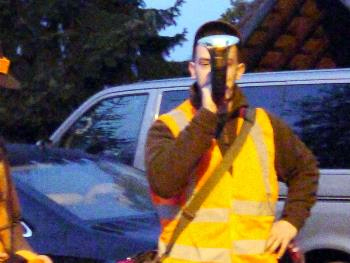 I enjoy the learning process: horn music from the hunter’s portable hunting horn for different stages of every game drive provided practical safety signals to hunters and was used later to eulogize the game killed.
The morning started with a bang. Moments after taking my stand, a red deer stag with 40 cm antlers stopped and stared at me from 30 yards away. I passed because my trophy on this hunt was the experience and I have plenty of trophies at home already. I had a mandate to shoot pigs and antlerless animals only; this was an odd mixture of a management hunt and a trophy hunt. The widespread devastation of corn has brought pressure from the Government and local farmers to extract a quota of pigs and part of the reason the government-owned and leased hunting camp exists here is to lower pig populations. Similarly, roe deer, fallow and red deer, but mostly pigs.
I enjoy the learning process: horn music from the hunter’s portable hunting horn for different stages of every game drive provided practical safety signals to hunters and was used later to eulogize the game killed.
The morning started with a bang. Moments after taking my stand, a red deer stag with 40 cm antlers stopped and stared at me from 30 yards away. I passed because my trophy on this hunt was the experience and I have plenty of trophies at home already. I had a mandate to shoot pigs and antlerless animals only; this was an odd mixture of a management hunt and a trophy hunt. The widespread devastation of corn has brought pressure from the Government and local farmers to extract a quota of pigs and part of the reason the government-owned and leased hunting camp exists here is to lower pig populations. Similarly, roe deer, fallow and red deer, but mostly pigs.
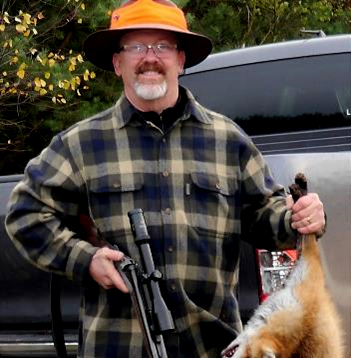 I drew first blood. A few minutes after the "start of the hunt" horn had been sounded and the dogs had begun their seeking cries from afar, a red fox was slinking up the bank. They are still shot as vermin here for stock stealing and reducing pheasant populations so I drilled him. I was carrying a “drilling” of sorts, right?
I drew first blood. A few minutes after the "start of the hunt" horn had been sounded and the dogs had begun their seeking cries from afar, a red fox was slinking up the bank. They are still shot as vermin here for stock stealing and reducing pheasant populations so I drilled him. I was carrying a “drilling” of sorts, right?
Here is where things got interesting, as I made a rookie mistake. I instinctively slapped in a fresh rifle cartridge, watched a small pig race between me and the next hunter. Then, mysteriously, a square black profile looking much like an 80 cm flat screen TV slid out of the dense brush right across the creek from me. Of course, it was a wildschwein—a wild boar—standing in profile at only 15 yards and clearly giving himself to me.
I smoothly raised the deadly gun, quickly sighted (which was more like pointing at that range) and pulled the trigger, thereby unleashing all hell. The hellishness came from the hollow click! as the hammer fell on an empty shotgun cartridge. Apparently I had slain the fox with the Brenneke slug and not realizing it, had replaced the unused rifle cartridge, leaving a spent slug in the shotgun barrel. The boar evaporated at the click; an easier shot is likely to never come again.
This brings me to an important point. I was much more prone to laugh than cry at that moment even though our hosts were mortified for me. That image of pig filling the Swarovski glass at 1.5 power and the hollow hammer fall will stay with me as permanently as any dead pig.
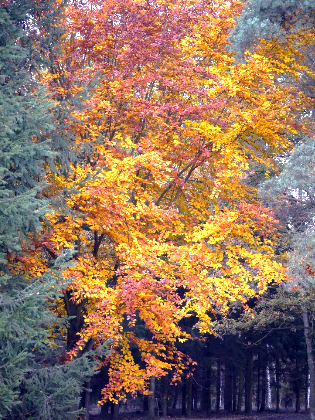 In a sense what I did on this hunt was to go back in time. I am an accomplished North American hunter of deer, geese, moose, bear, pheasant, alligators, woodcock, frogs and many other species over a 54 year hunting career. In Poland, however, I thrust myself into a totally new hunting setting; a new and complex language, a new suite of target species, a new country, a new and different rifle, a new hunting style, new foreign hunting companions, and a flora whose Latin names I could only approximate. The gift of this situation is that I had walked back to the newness and joy of my childhood hunting. I was back to the falling in love stage of a relationship. This girlfriend called belle chasse was sending me a love note. The peak of fall color was upon us and the forest was idyllic.
In a sense what I did on this hunt was to go back in time. I am an accomplished North American hunter of deer, geese, moose, bear, pheasant, alligators, woodcock, frogs and many other species over a 54 year hunting career. In Poland, however, I thrust myself into a totally new hunting setting; a new and complex language, a new suite of target species, a new country, a new and different rifle, a new hunting style, new foreign hunting companions, and a flora whose Latin names I could only approximate. The gift of this situation is that I had walked back to the newness and joy of my childhood hunting. I was back to the falling in love stage of a relationship. This girlfriend called belle chasse was sending me a love note. The peak of fall color was upon us and the forest was idyllic.
This was the satisfaction of mastery through a cautious honing and balancing of uncertainty and responses. The core of safety, etiquette, anticipation, and insight were there, but the smooth timing of leading an open-field sprinting pig while calculating background safety, presence of dogs, lead angles and trigger selection were for me still thought-requiring processes, instead of Bernard and Christian’s polished swing and shoot technique. My sense is this is bigger than trophy acquisition. I was as out of my element as Bernhard might have been at Fort Belknap, Montana standing in a Native reservation shack with dried meat strung across a yard filled with paint ponies and feral pigs rooting underneath foot.
In Poland, for me the experience trumped the game bag. I was still hunting for experience and a universal decision/reaction sequence; they were polishing their skills. Christian kept insisting I switch firearms with him but I needed to finish today at least with this Ferlach, or as I am going to rename the Fur-Lack as “The Hairless.” Maybe I could just rename it Ricardo.
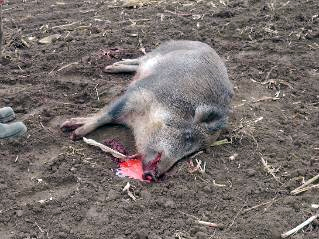 Three later boar encounters did not go my way either. The first was a medium-sized pig racing between me and the adjacent shooter and we both refused the shot for safety. Later, the dogs unleashed a porcine jihad on a patch of corn from which roe deer dashed out of 3 sides and two mature pigs squirted out at random, one racing by 80 yards to my right. Two slow shots and I was empty. I intended to pass on another at 100 yards but Søren was working his 9.3 x 62 steadily and after 2 shots I joined in the fusillade. But it was Søren’s 3rd shot that made the mature sow do a complete end-over as the dogs fell upon her, worrying the bristles of her tough carcass.
Three later boar encounters did not go my way either. The first was a medium-sized pig racing between me and the adjacent shooter and we both refused the shot for safety. Later, the dogs unleashed a porcine jihad on a patch of corn from which roe deer dashed out of 3 sides and two mature pigs squirted out at random, one racing by 80 yards to my right. Two slow shots and I was empty. I intended to pass on another at 100 yards but Søren was working his 9.3 x 62 steadily and after 2 shots I joined in the fusillade. But it was Søren’s 3rd shot that made the mature sow do a complete end-over as the dogs fell upon her, worrying the bristles of her tough carcass.
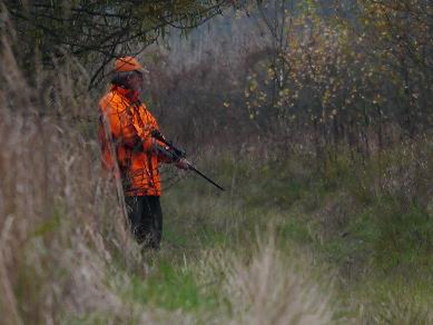 I had been wondering why I was feeling a little tired by the time we reached drive # 8 for the day. But standing up for 8 hours of fresh wind and intermittent rain, plus loading in and out of trucks takes its toll. And feeling like fully being in the moment of constant anticipation is pleasantly exhausting. Realistically, I was battling jet lag; intensely focused on hunting, which is all encompassing; and as great chess masters remind us, attention burns energy. Plus I am over 60 now: there was that delicious lunch served in the field that was calling me to be horizontal for a few minutes. I hunted through it. A 16 oz beer to hand at days end contraindicates alertness.
I had been wondering why I was feeling a little tired by the time we reached drive # 8 for the day. But standing up for 8 hours of fresh wind and intermittent rain, plus loading in and out of trucks takes its toll. And feeling like fully being in the moment of constant anticipation is pleasantly exhausting. Realistically, I was battling jet lag; intensely focused on hunting, which is all encompassing; and as great chess masters remind us, attention burns energy. Plus I am over 60 now: there was that delicious lunch served in the field that was calling me to be horizontal for a few minutes. I hunted through it. A 16 oz beer to hand at days end contraindicates alertness.
There were some spots in mature oak and beech forests with full canopies of golden leaves that produced the reverential feeling of nature. It was also in the front of my mind that these bowering forests are sometimes called “cathedral forests” for their tall enclosed environment with the music of dogs reverberating, hunter’s horn and occasionally the shared roar of a firearm, all played out in an enclosed theater. At other times the hunters on stands looked as cloistered as the reverential John in the wilderness or possibly pilgrims on a quest. A shared stand. Talked too much. Saw 45 red deer running through dense forest. Did not get a good shot. Had fun. Selfie trick learned from daughters.
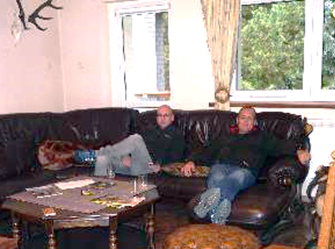 Standing in a ravaged cornfield near a woodland peninsula of woodland on the day’s 8th drive brought us a leaden sky punctuated by flocks of purposeful geese and a large tawny eagle bearing the wrath of crows. For a moment, it was Alberta-like. Poland would offer great waterfowl and crane hunting for Greylag Geese and Canada Geese. It was a pleasant distraction.
Standing in a ravaged cornfield near a woodland peninsula of woodland on the day’s 8th drive brought us a leaden sky punctuated by flocks of purposeful geese and a large tawny eagle bearing the wrath of crows. For a moment, it was Alberta-like. Poland would offer great waterfowl and crane hunting for Greylag Geese and Canada Geese. It was a pleasant distraction.
The return to the lodge, which was adorned with modest mounted heads, a ripping fireplace, hot showers and the smells of traditional Polish cooking was a treat. Actually, half a litre of beer and putting my feet up were a delight too.
The pre-dawn light of day 3 saw us trundling through the narrow lanes and a patchwork of decrepit stone buildings that Matt had said exceeded 200 years old. We clutched our rucksacks and swaying rifles in the warmth of an old diesel cargo van as we bumped through mud and gravel. Though we only caught glimpses of the passing countryside, I said it reminded me of a WWII movie. Christian replied that his father had been drafted into Hitler’s youth army at the age of 14 to be an anti-aircraft gunner before deserting and walking back to Hamburg. The irony was palpable. His father may well have been shooting at the very men that would father me and Matt. Casting back 71 years, would they have believed it if told their sons would one day be sharing weapons, ammo and laughs as they rode knee-to knee in a van on a hunting trip through central Poland?
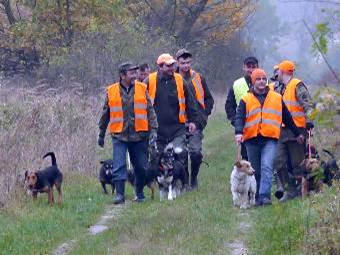 This evening I put a question to Dr. Bernhard Richter who is the CEO and advisor for a German land-management group and Christian, whose real job is as a resource economist from Germany and Canada. How did the driven boar and deer hunt we were experiencing compare to the German version of the same? Their answers were thoughtful but suggested this was a more relaxed affair, to put it politely. The German hunts were typically carried out for longer hunt sessions and hunter shooting lanes and view-scapes were situated in a more distributed drape across the country as beaters moved more discretely through hill and dale gently pushing game into incidental visibility. Overall, it seems the Germans carry the rituals and formality to a finer point. More country-club and less farmer hunting. But to this crowd, the very grittiness of muddied boots, eye-level close-shooting of game and frequent moves to fresh country was like a varied meal of hors de oeuvres eaten with one’s fingers rather than a smoking jacket-clad sit down supper. Both are rewarding but carry different rules.
This evening I put a question to Dr. Bernhard Richter who is the CEO and advisor for a German land-management group and Christian, whose real job is as a resource economist from Germany and Canada. How did the driven boar and deer hunt we were experiencing compare to the German version of the same? Their answers were thoughtful but suggested this was a more relaxed affair, to put it politely. The German hunts were typically carried out for longer hunt sessions and hunter shooting lanes and view-scapes were situated in a more distributed drape across the country as beaters moved more discretely through hill and dale gently pushing game into incidental visibility. Overall, it seems the Germans carry the rituals and formality to a finer point. More country-club and less farmer hunting. But to this crowd, the very grittiness of muddied boots, eye-level close-shooting of game and frequent moves to fresh country was like a varied meal of hors de oeuvres eaten with one’s fingers rather than a smoking jacket-clad sit down supper. Both are rewarding but carry different rules.
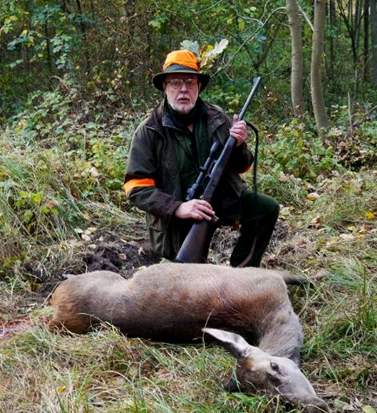 The introduction to countryside, new species (to me), unusual dog-and-beater work and game handling were all gifts to the curious and experiential hunters. A few things felt odd though; it slowly became clear that we were part of a larger plan for sustainable animal harvesting, population management and regional tourism business.
The introduction to countryside, new species (to me), unusual dog-and-beater work and game handling were all gifts to the curious and experiential hunters. A few things felt odd though; it slowly became clear that we were part of a larger plan for sustainable animal harvesting, population management and regional tourism business.
When an animal was killed, it was graced with a laurel branch then the hunter was given a bit of greenery to place in their hat band for the day.
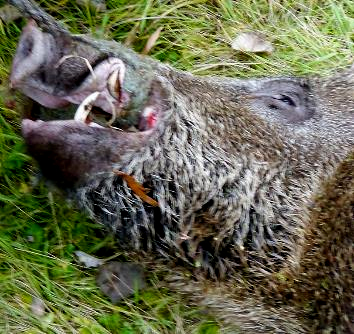 Each animal was quickly eviscerated and stacked on an open-air wagon to cool as it was pulled behind the tractor. The carcasses were now owned by the government for sale in local markets. Any trophies (antlers, teeth, photos) were processed and given to the hunters. The beaters and dogs rode in a separate wagon fitted with a woodstove that was also pulled by the tractor. The hunters were asked to shoot up to 30 pigs of any size to aid in animal damage control; unlimited numbers of young and antlerless of the roe deer, red deer, fallow deer to reduce their impact on re-forestation and crops; and to please shoot any predators (raccoon dogs, foxes, polecats, otters, and badgers) to reduce predation on pheasants and chickens.
Each animal was quickly eviscerated and stacked on an open-air wagon to cool as it was pulled behind the tractor. The carcasses were now owned by the government for sale in local markets. Any trophies (antlers, teeth, photos) were processed and given to the hunters. The beaters and dogs rode in a separate wagon fitted with a woodstove that was also pulled by the tractor. The hunters were asked to shoot up to 30 pigs of any size to aid in animal damage control; unlimited numbers of young and antlerless of the roe deer, red deer, fallow deer to reduce their impact on re-forestation and crops; and to please shoot any predators (raccoon dogs, foxes, polecats, otters, and badgers) to reduce predation on pheasants and chickens.
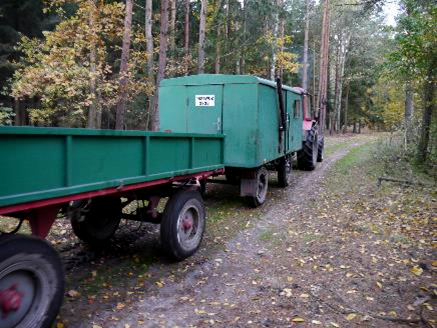
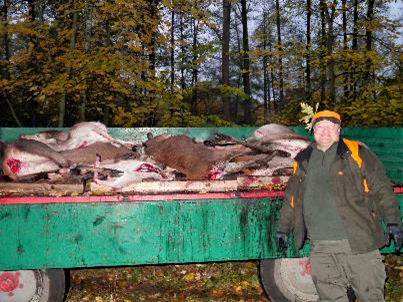
The neat and modern lodge is the oldest government-owned facility devoted to hunting in the region. It employs local people for cooks, guides, interpreters, beaters and dog-handlers and it seems to be a point of pride in the way Zimigrod’s chamber of commerce supports and brands it. I can only imagine that the $15,000 per day our group of 11 shared for guide fees, trophy fees and tips generated is a significant cash input into the local system, not to mention the thousand kilos of market-bound venison and pork being sold regionally at $5 per kilogram. The drivers’ dogs and meat wagon were hauled about on a tractor. I thought it was cool, ummm warm, to have a wood stove inside the wagon
For us, this was inexpensive hunting in the grand scheme of things. We didn’t need 4 x 4’s, dogs, cooks, food handling, lodging, landowner permissions, or wayfinding. If we had persisted for longer than 3 days I know we would start to miss the familiarity of tracking, meat-handling, and cooking our own quarry. As it was, however, we functioned as part of a larger system and that was as the shooters, not a trivial role. That we were moved efficiently to 8 different high-quality shooting locations per day made it clear that we had a role to play in extracting venison. Several of our members opted to take trophy animals at $500-3000 Euros per head too.
The last night brought a ceremony of presenting the day’s harvest, sincere thanks to beaters and dogs, a roaring bonfire, vodka and schnapps salutes, some gratuity distribution and a lot of photographs. There was no sense of jaded ritual or anyone hustling anyone else as sometimes appears in African safaris. I sincerely believe that some genuine affection emerged and this was because of the people involved. The staff who shared our quarters were all women who did cooking and interpretation; our head guide was a young resource manager, when not farming or engaged in the trades, the beaters seemed to throw themselves into their work, loved their dogs and seemed to take their salaried positions as appreciative work of striding though forests and helping rouse game and find shot animals. Having our very own larger than life Matt shouting Polish witticisms, bear-hugging the guides, and diving into knife-work on animals was a 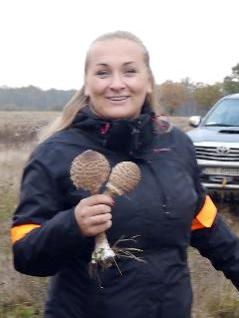 different experience for the staff and served as an interesting social lubricant. It is unlikely staff get to drink a shot of vodka with hunters very often as they did on our last night.
different experience for the staff and served as an interesting social lubricant. It is unlikely staff get to drink a shot of vodka with hunters very often as they did on our last night.
I was impressed at the comfortable lack of pretense and rigidity of the whole affair. It had enough structure and emphasis on rule-following for safety and understanding, yet was not so slavishly adherent to expectations and protocol that we were made to feel foolish or pawn-like. We have plenty of that in our work lives and this served as a true diversion; it stayed a hunting camp. Someday, I would indeed like to experience and photograph the Swiss or German hunting style but it is likely that language barriers alone if not my preference for a carefree egalitarianism, would keep me in the tourist-hunter category there. Because I speak Spanish, I know from bird hunting in Cuba and our forthcoming Argentina dove hunt that an ability to communicate is key in getting the most of a foreign hunting situation.This is a multi-use forest with bike trails and abundant mushroom pickers and we saw many babushkas biking full baskets of mushrooms down the trails.
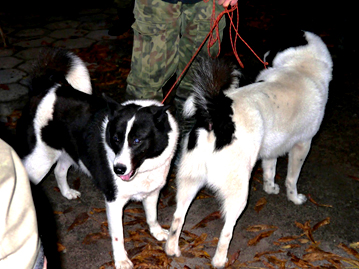 This hunt was different because the hunters were stationary and the drivers and dogs moved game around. I found myself wanting to be walking the forest with a group of dogs occasionally but I do that at home. This was new and special. The dogs took delight in extending the driver’s influence and they all took a special interest in pushing pigs as indicated by the high pitched barking. The boars are well equipped with slashing tusks, sometimes called “tushes” where I grew up and a few dogs got cut up in the line of duty including a broken jaw, a cut behind the ear and a nipped hindquarter.
Theirs was a variety pack of small terriers and two largish Karelean looking fight dogs called Laikas. This all became important when a boar finally made a stand to fight instead of running.
This hunt was different because the hunters were stationary and the drivers and dogs moved game around. I found myself wanting to be walking the forest with a group of dogs occasionally but I do that at home. This was new and special. The dogs took delight in extending the driver’s influence and they all took a special interest in pushing pigs as indicated by the high pitched barking. The boars are well equipped with slashing tusks, sometimes called “tushes” where I grew up and a few dogs got cut up in the line of duty including a broken jaw, a cut behind the ear and a nipped hindquarter.
Theirs was a variety pack of small terriers and two largish Karelean looking fight dogs called Laikas. This all became important when a boar finally made a stand to fight instead of running.
This hunt was different though because the pigs were being pushed and worried, not captured. Dogs became an extension of the walking drivers as the dogs wandered through sloughs, brush piles, thickets and ensured animals were flushed out to where shooters might bag them.
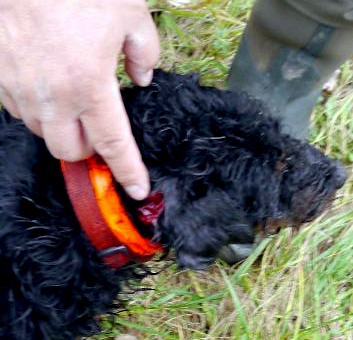
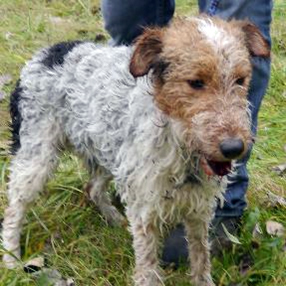
This terrier got a banged up jaw. This little guy got a nice bite on the head.
So it was off to the vet for these fallen soldiers and more dogs were brought in.
The dogs were what Richard calls a Bobbery pack. That is, a pack of mixed breeds working together. Bobbery literally comes from Hindi I learned where it means a raucous crying out, such as “Our Father!”. These dogs, being good Polish Catholics were probably saying the Rosary but it worked well on the pig flushing. Our group of hunters probably qualified as a bobbery pack. Whereas pig catching that I am familiar with usually involves a mixed pack (a bobbery – what s stupid sounding word) with some trailing dogs such as Redbones, Blueticks, Plott hounds and Walkers, for the flushing and melee of worrying a pig, some small darting terriers such as Jagdterriers, Airedales or even Jack Russells, and for the big muscular work, some catch dogs such as pit bulls, mastiffs, or even the large European terriers. Pig catching is intense and dangerous work so the dogs are usually fitted with leather or kevlar vests so when they grab an ear (the typical hold) the sharp tusks thrust upward into impermeable material instead of the dog’s neck and chest. These dogs were not supposed to actually catch the pigs, rather, to push them around some for the shooters.
Where I grew up a, generic hog dog was bred into the Catahoula Hound that did all of these things. Pigs can be immobilized from the front or the rear. A head-held boar is going to fight. If a person can grab and lift or lasso and pull their back legs, the pig is handleable or even killable with a knife or spear thrust between the ribs. This is a long time-honored way of euthanizing wild pigs requiring strength, quickness and big cajones (hunter, not pig).
I could clearly hear the dogs stall and take the fight to the boar and there was a furious melee for about 10 minutes replete with yelping, grunting and 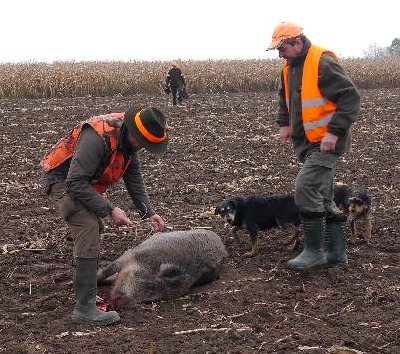 squealing. Christian kept his sights on the boar but couldn’t shoot for fear of hitting a dog as they spun and clung to various tough patches of pig hide. The boar was bringing the fight to the dogs and slashing them with upturned tusk. Finally, the guides cleared enough dogs that Bernhard could walk in for the coup de grace and two quick slugs into the forequarters delivered the lethal shots but lethality takes time and in a flash the slowed but living pig rushed Bernard, threw him to the ground and what was probably an instinctive self-defense move, Bernhard thrust his gun butt at the pig who got his mouth on the canvas rifle sling. The Blaser’s beautifully figured rosewood stock, barrel and Swarovski scope went racing off through the forest some 10 meters with the pig’s slobbering tusks working over the strap. One of the guides snatched up the fallen rifle and shot on the dying pig some more. It was an exciting moment of hunter, quarry, dog and beater all in on the action.
squealing. Christian kept his sights on the boar but couldn’t shoot for fear of hitting a dog as they spun and clung to various tough patches of pig hide. The boar was bringing the fight to the dogs and slashing them with upturned tusk. Finally, the guides cleared enough dogs that Bernhard could walk in for the coup de grace and two quick slugs into the forequarters delivered the lethal shots but lethality takes time and in a flash the slowed but living pig rushed Bernard, threw him to the ground and what was probably an instinctive self-defense move, Bernhard thrust his gun butt at the pig who got his mouth on the canvas rifle sling. The Blaser’s beautifully figured rosewood stock, barrel and Swarovski scope went racing off through the forest some 10 meters with the pig’s slobbering tusks working over the strap. One of the guides snatched up the fallen rifle and shot on the dying pig some more. It was an exciting moment of hunter, quarry, dog and beater all in on the action.
Pigs are not the classic dangerous game but close action can be serious as these injuries sustained by the dogs attest with gashes, broken jaws and punctures. It is what they live for, not unlike a boxer or mixed martial arts fighter. It was an impressive event that could have ended much worse for the human hunter and such is the joyous nature of a hunt where one embraces risks. Boars are the only hunted species here that approaches dangerous game status and even then, one has to hunt them in a fair and honorable way on foot to acknowledge the risk. Hunting from an elevated stand has none of this and my opinion is that while an elegant shooting sport, there is more experiential immersion when one gets their boots muddy, sees their quarry eye to eye, and helps protect their pack. It is not surprising to me that tactile hunting (spear, archery, knife) and fishing (alligator lining, catfish noodling, and spear gunning for big fish) still 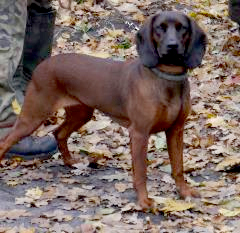 provides a desirable and elemental draw.
provides a desirable and elemental draw.
For lost game there was a specialized trailing dog called the Bavarian Mountain bloodhound, a beautiful animal who always worked on leash.
Ultimately though, the boars paid a higher price in this battle. Some of the dogs kept returning to worry the dead carcass. Vengeful little devils.
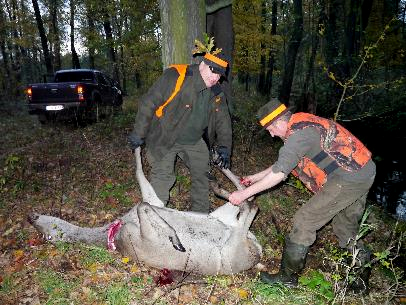 There were many hours of sitting, thus many deer taken too.
A big hind red deer raced up to within 15 feet of me, while I was peeing. She promptly got shot, then plunged into the creek, dying as she hit the water. Here Frannic and Matt do initial processing while I shoot photos. Smart, huh? Trophies were cleaned overnight and processed for transport the next morning.
There were many hours of sitting, thus many deer taken too.
A big hind red deer raced up to within 15 feet of me, while I was peeing. She promptly got shot, then plunged into the creek, dying as she hit the water. Here Frannic and Matt do initial processing while I shoot photos. Smart, huh? Trophies were cleaned overnight and processed for transport the next morning.
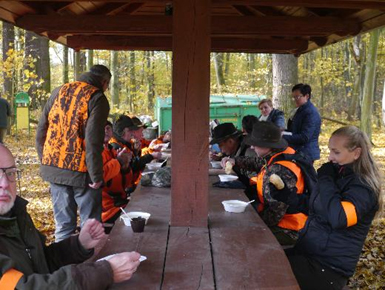 Mid-day each day the cooks brought hearty lunches to the field to meet us. Typically it was hearty meaty soups, bread and cheese washed down with hot coffee. Delicious. The last evening there was some ceremony to acknowledge and honor the game taken. A horn call was played for each group of animals, the red deer song, the roe deer song, the wild boar song etc. The quarry was all laid out on evergreen boughs near a roaring fire and the hunters all toasted the animals for giving their lives and the drivers were given a round of applause. Frannich was slightly mortified that we hadn’t killed the usual 30 or so boars but because of the late fall rains, the crops had not been harvested and the pigs were still scattered through the un-huntable corn fields. Our forester Frannich (Francis) is a serious dude but I will compliment his efficiency with moving us rapidly around the countryside from corn field to bottomlands to oak-beech woodland to cut blocks. It was a virtual crash course in silviculture.
Mid-day each day the cooks brought hearty lunches to the field to meet us. Typically it was hearty meaty soups, bread and cheese washed down with hot coffee. Delicious. The last evening there was some ceremony to acknowledge and honor the game taken. A horn call was played for each group of animals, the red deer song, the roe deer song, the wild boar song etc. The quarry was all laid out on evergreen boughs near a roaring fire and the hunters all toasted the animals for giving their lives and the drivers were given a round of applause. Frannich was slightly mortified that we hadn’t killed the usual 30 or so boars but because of the late fall rains, the crops had not been harvested and the pigs were still scattered through the un-huntable corn fields. Our forester Frannich (Francis) is a serious dude but I will compliment his efficiency with moving us rapidly around the countryside from corn field to bottomlands to oak-beech woodland to cut blocks. It was a virtual crash course in silviculture.

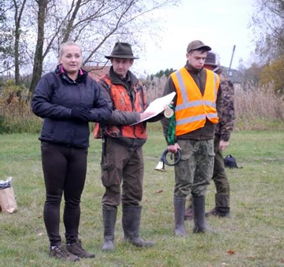
This was an incidental trophy hunt but at its core, was a "meat and meaning" hunt of management and seeing country; learning about animals, foods, customs, landscapes and dogs that were new to me and very interesting.
Not to be maudlin or overly New-Ageish, but trophies take on many meanings in these situations and some are intangibles and memories. Photos and text help immortalize as effectively as antlers and tusks. Both are better than either alone. It is important to me to emerge from experiences a better person, with a broader understanding, a broader base against which to relativize other things life (and death) hands me. This is one of the real gifts of nature.
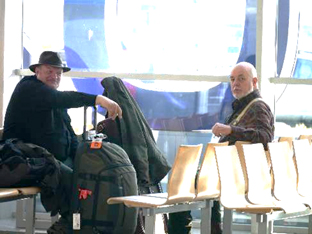
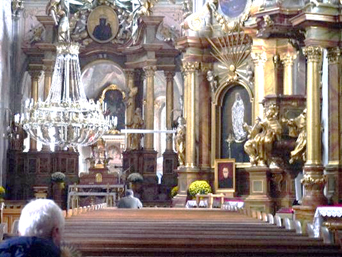 We had to ease out of the hunting mindset on our way to the airport for our flight to Warsaw. No guns, well bathed, and culture supplanted the hunt attention: it would soon be time to fly home. I found myself scanning the Polish countryside for game... and saw some. Matt the congenital Catholic (in the front row) bracketed our trip by seeking absolution for his hunting exploits at an ornate Polish Catholic church. Hope he prayed for me too.
We had to ease out of the hunting mindset on our way to the airport for our flight to Warsaw. No guns, well bathed, and culture supplanted the hunt attention: it would soon be time to fly home. I found myself scanning the Polish countryside for game... and saw some. Matt the congenital Catholic (in the front row) bracketed our trip by seeking absolution for his hunting exploits at an ornate Polish Catholic church. Hope he prayed for me too.
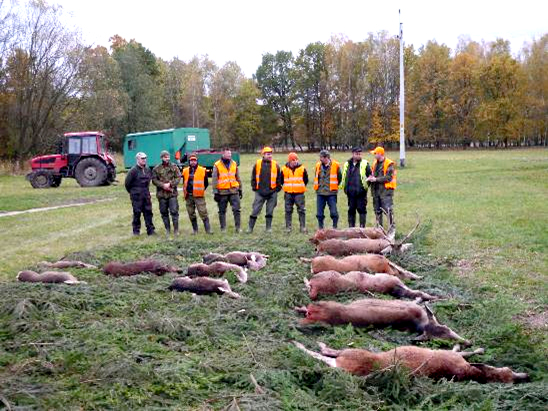
I am impressed with Poland’s culture, climate, people, low rates of commercial tourism, great food, amount of forest cover and beautiful countryside. I will be back as a tourist, hunter or just traveler.
| HUNTING | GUNS | DOGS |
| FISHING & BOATING | TRIP REPORTS | MISCELLANEOUS ESSAYS |
| CONTRIBUTIONS FROM OTHER WRITERS|
| RECIPES |POLITICS |
 The KLM wheels touched the tarmac at Warsaw, Poland near suppertime and to say my hunting partner Matt "met" me would be an understatement. More like he snatched me up and the whirlwind began. He bundled us into a Taxi—a Diesel BMW 530 of all things—and a hand-waving, rapid-fire discussion in Polish ensued as the driver whisked us across town, while Matt animatedly discussed drinking, women, hotels, and ordered our meal ahead of time. Matt is a Polish-Canadian who happens to be Polish-fluent and has family in Warsaw. He was our "whip" and facilitator, launching into conversations with cabbies, waiters, cooks and saying things that sounded like: “Pushta neim gorchek knee bolk!” They respond by speaking backwards to him as if they understood his gibberish. I'd have thought they were humoring the feebleminded except they tended to hug him, proffer vodka and give helpful directions.
The KLM wheels touched the tarmac at Warsaw, Poland near suppertime and to say my hunting partner Matt "met" me would be an understatement. More like he snatched me up and the whirlwind began. He bundled us into a Taxi—a Diesel BMW 530 of all things—and a hand-waving, rapid-fire discussion in Polish ensued as the driver whisked us across town, while Matt animatedly discussed drinking, women, hotels, and ordered our meal ahead of time. Matt is a Polish-Canadian who happens to be Polish-fluent and has family in Warsaw. He was our "whip" and facilitator, launching into conversations with cabbies, waiters, cooks and saying things that sounded like: “Pushta neim gorchek knee bolk!” They respond by speaking backwards to him as if they understood his gibberish. I'd have thought they were humoring the feebleminded except they tended to hug him, proffer vodka and give helpful directions. 
 The next morning we walked the historic town for 3 hours, toured cathedrals, and visited a European gun shop situated in a home in the suburbs. Here Matt (on right) had to do some more hugging of the proprietor.
The next morning we walked the historic town for 3 hours, toured cathedrals, and visited a European gun shop situated in a home in the suburbs. Here Matt (on right) had to do some more hugging of the proprietor. particularly pretty church with the Black Madonna on display, hopefully is praying for a successful hunt. We thought that when his arch Catholic Italian wife Lucia sees this he may get sent to Poland
particularly pretty church with the Black Madonna on display, hopefully is praying for a successful hunt. We thought that when his arch Catholic Italian wife Lucia sees this he may get sent to Poland  more often. This lectern is named after the elevated hunting stands used in Europe. How appropriate!
more often. This lectern is named after the elevated hunting stands used in Europe. How appropriate!
 In addition to Matt I had several wise tour guide friends on this trip. German/Canadian forest economist Christian Schadendorf (right) did the majority of the hunt arranging and he and Bernhard met us at sunset, driving us an hour north to a woodland lodge. There we would be based to shoot wild boars among other things. It seems boars are the scourge of the countryside, but more on that later. The name of the place, above left, is Kwatera Mysliwska in Zmigrod, Poland. It is a country-owned facility that leases space out to visiting groups who are hunting. We were one such group. Part of the fee to the Polish government covers a full time translator. In our case, a pretty blonde woman who had a dorm room in the lodge and went into the field with the hunting crew.
In addition to Matt I had several wise tour guide friends on this trip. German/Canadian forest economist Christian Schadendorf (right) did the majority of the hunt arranging and he and Bernhard met us at sunset, driving us an hour north to a woodland lodge. There we would be based to shoot wild boars among other things. It seems boars are the scourge of the countryside, but more on that later. The name of the place, above left, is Kwatera Mysliwska in Zmigrod, Poland. It is a country-owned facility that leases space out to visiting groups who are hunting. We were one such group. Part of the fee to the Polish government covers a full time translator. In our case, a pretty blonde woman who had a dorm room in the lodge and went into the field with the hunting crew.  Our hunting party was very euro-centric with dual
Our hunting party was very euro-centric with dual  citizens from Polish-American, American-Canadian, German-Canadian, Danish, Polish, German. There were some car rides where hand-signals and pointing were required to communicate. World War III did not break out. While Matt was being friendly with the cook staff, another hunter, Richard “Ricardo” Spilker sat on a throne of antlers. We only belatedly discovered Richard holds a Bachelor of Jurisprudence, hence, should be "Mr. Spilker, LLB" but don’t tell him that or hat sizes may change.
citizens from Polish-American, American-Canadian, German-Canadian, Danish, Polish, German. There were some car rides where hand-signals and pointing were required to communicate. World War III did not break out. While Matt was being friendly with the cook staff, another hunter, Richard “Ricardo” Spilker sat on a throne of antlers. We only belatedly discovered Richard holds a Bachelor of Jurisprudence, hence, should be "Mr. Spilker, LLB" but don’t tell him that or hat sizes may change. 
 By design we arrived in Poland without rifles, shells or knives, for expediency in various border patrol and customs clearances. It is not trivial to take firearms into Poland but it can be done by someone who follows the rules and files the paperwork. We were lucky to have European friends with good arsenals who provided for us. Both Christian and Bernard have well-stocked gun vaults and had promised to provide for us, which they did with beautiful exotica. A couple of Bernhard’s Blaser rifles had some of the most beautiful wood grain I have ever seen.
There were all sorts of interesting rifles including Christian’s Sauer .30-06 with the slickest bolt action of all time.
By design we arrived in Poland without rifles, shells or knives, for expediency in various border patrol and customs clearances. It is not trivial to take firearms into Poland but it can be done by someone who follows the rules and files the paperwork. We were lucky to have European friends with good arsenals who provided for us. Both Christian and Bernard have well-stocked gun vaults and had promised to provide for us, which they did with beautiful exotica. A couple of Bernhard’s Blaser rifles had some of the most beautiful wood grain I have ever seen.
There were all sorts of interesting rifles including Christian’s Sauer .30-06 with the slickest bolt action of all time.  I was handed an interesting double-trigger side by side shotgun rifle combo built by Ferlach and called a “Cape Gun.” Could be a pig and pigeon combo or a slug and rifle. It was a 8x57 rifle and a 16 gauge smoothbore melded into a double-gun. Two triggers, beautiful checkering and fine engraving. I think it would make my gun nut friends a little moist. Whole lotta variables at play here: A gun with two types of ammo, two different trigger pulls, with very different trajectories and leads: roll with it! It was one of the hundreds of thousands of German firearms that were hidden or buried across the country after WWII Armistice required Germany’s populace to be firearm-free. Later unearthed and repaired, it makes a fine hunting piece, except I didn’t shoot it well.
I was handed an interesting double-trigger side by side shotgun rifle combo built by Ferlach and called a “Cape Gun.” Could be a pig and pigeon combo or a slug and rifle. It was a 8x57 rifle and a 16 gauge smoothbore melded into a double-gun. Two triggers, beautiful checkering and fine engraving. I think it would make my gun nut friends a little moist. Whole lotta variables at play here: A gun with two types of ammo, two different trigger pulls, with very different trajectories and leads: roll with it! It was one of the hundreds of thousands of German firearms that were hidden or buried across the country after WWII Armistice required Germany’s populace to be firearm-free. Later unearthed and repaired, it makes a fine hunting piece, except I didn’t shoot it well. I enjoy the learning process: horn music from the hunter’s portable hunting horn for different stages of every game drive provided practical safety signals to hunters and was used later to eulogize the game killed.
The morning started with a bang. Moments after taking my stand, a red deer stag with 40 cm antlers stopped and stared at me from 30 yards away. I passed because my trophy on this hunt was the experience and I have plenty of trophies at home already. I had a mandate to shoot pigs and antlerless animals only; this was an odd mixture of a management hunt and a trophy hunt. The widespread devastation of corn has brought pressure from the Government and local farmers to extract a quota of pigs and part of the reason the government-owned and leased hunting camp exists here is to lower pig populations. Similarly, roe deer, fallow and red deer, but mostly pigs.
I enjoy the learning process: horn music from the hunter’s portable hunting horn for different stages of every game drive provided practical safety signals to hunters and was used later to eulogize the game killed.
The morning started with a bang. Moments after taking my stand, a red deer stag with 40 cm antlers stopped and stared at me from 30 yards away. I passed because my trophy on this hunt was the experience and I have plenty of trophies at home already. I had a mandate to shoot pigs and antlerless animals only; this was an odd mixture of a management hunt and a trophy hunt. The widespread devastation of corn has brought pressure from the Government and local farmers to extract a quota of pigs and part of the reason the government-owned and leased hunting camp exists here is to lower pig populations. Similarly, roe deer, fallow and red deer, but mostly pigs.  I drew first blood. A few minutes after the "start of the hunt" horn had been sounded and the dogs had begun their seeking cries from afar, a red fox was slinking up the bank. They are still shot as vermin here for stock stealing and reducing pheasant populations so I drilled him. I was carrying a “drilling” of sorts, right?
I drew first blood. A few minutes after the "start of the hunt" horn had been sounded and the dogs had begun their seeking cries from afar, a red fox was slinking up the bank. They are still shot as vermin here for stock stealing and reducing pheasant populations so I drilled him. I was carrying a “drilling” of sorts, right? In a sense what I did on this hunt was to go back in time. I am an accomplished North American hunter of deer, geese, moose, bear, pheasant, alligators, woodcock, frogs and many other species over a 54 year hunting career. In Poland, however, I thrust myself into a totally new hunting setting; a new and complex language, a new suite of target species, a new country, a new and different rifle, a new hunting style, new foreign hunting companions, and a flora whose Latin names I could only approximate. The gift of this situation is that I had walked back to the newness and joy of my childhood hunting. I was back to the falling in love stage of a relationship. This girlfriend called belle chasse was sending me a love note. The peak of fall color was upon us and the forest was idyllic.
In a sense what I did on this hunt was to go back in time. I am an accomplished North American hunter of deer, geese, moose, bear, pheasant, alligators, woodcock, frogs and many other species over a 54 year hunting career. In Poland, however, I thrust myself into a totally new hunting setting; a new and complex language, a new suite of target species, a new country, a new and different rifle, a new hunting style, new foreign hunting companions, and a flora whose Latin names I could only approximate. The gift of this situation is that I had walked back to the newness and joy of my childhood hunting. I was back to the falling in love stage of a relationship. This girlfriend called belle chasse was sending me a love note. The peak of fall color was upon us and the forest was idyllic.  Three later boar encounters did not go my way either. The first was a medium-sized pig racing between me and the adjacent shooter and we both refused the shot for safety. Later, the dogs unleashed a porcine jihad on a patch of corn from which roe deer dashed out of 3 sides and two mature pigs squirted out at random, one racing by 80 yards to my right. Two slow shots and I was empty. I intended to pass on another at 100 yards but Søren was working his 9.3 x 62 steadily and after 2 shots I joined in the fusillade. But it was Søren’s 3rd shot that made the mature sow do a complete end-over as the dogs fell upon her, worrying the bristles of her tough carcass.
Three later boar encounters did not go my way either. The first was a medium-sized pig racing between me and the adjacent shooter and we both refused the shot for safety. Later, the dogs unleashed a porcine jihad on a patch of corn from which roe deer dashed out of 3 sides and two mature pigs squirted out at random, one racing by 80 yards to my right. Two slow shots and I was empty. I intended to pass on another at 100 yards but Søren was working his 9.3 x 62 steadily and after 2 shots I joined in the fusillade. But it was Søren’s 3rd shot that made the mature sow do a complete end-over as the dogs fell upon her, worrying the bristles of her tough carcass.  I had been wondering why I was feeling a little tired by the time we reached drive # 8 for the day. But standing up for 8 hours of fresh wind and intermittent rain, plus loading in and out of trucks takes its toll. And feeling like fully being in the moment of constant anticipation is pleasantly exhausting. Realistically, I was battling jet lag; intensely focused on hunting, which is all encompassing; and as great chess masters remind us, attention burns energy. Plus I am over 60 now: there was that delicious lunch served in the field that was calling me to be horizontal for a few minutes. I hunted through it. A 16 oz beer to hand at days end contraindicates alertness.
I had been wondering why I was feeling a little tired by the time we reached drive # 8 for the day. But standing up for 8 hours of fresh wind and intermittent rain, plus loading in and out of trucks takes its toll. And feeling like fully being in the moment of constant anticipation is pleasantly exhausting. Realistically, I was battling jet lag; intensely focused on hunting, which is all encompassing; and as great chess masters remind us, attention burns energy. Plus I am over 60 now: there was that delicious lunch served in the field that was calling me to be horizontal for a few minutes. I hunted through it. A 16 oz beer to hand at days end contraindicates alertness. Standing in a ravaged cornfield near a woodland peninsula of woodland on the day’s 8th drive brought us a leaden sky punctuated by flocks of purposeful geese and a large tawny eagle bearing the wrath of crows. For a moment, it was Alberta-like. Poland would offer great waterfowl and crane hunting for Greylag Geese and Canada Geese. It was a pleasant distraction.
Standing in a ravaged cornfield near a woodland peninsula of woodland on the day’s 8th drive brought us a leaden sky punctuated by flocks of purposeful geese and a large tawny eagle bearing the wrath of crows. For a moment, it was Alberta-like. Poland would offer great waterfowl and crane hunting for Greylag Geese and Canada Geese. It was a pleasant distraction.  This evening I put a question to Dr. Bernhard Richter who is the CEO and advisor for a German land-management group and Christian, whose real job is as a resource economist from Germany and Canada. How did the driven boar and deer hunt we were experiencing compare to the German version of the same? Their answers were thoughtful but suggested this was a more relaxed affair, to put it politely. The German hunts were typically carried out for longer hunt sessions and hunter shooting lanes and view-scapes were situated in a more distributed drape across the country as beaters moved more discretely through hill and dale gently pushing game into incidental visibility. Overall, it seems the Germans carry the rituals and formality to a finer point. More country-club and less farmer hunting. But to this crowd, the very grittiness of muddied boots, eye-level close-shooting of game and frequent moves to fresh country was like a varied meal of hors de oeuvres eaten with one’s fingers rather than a smoking jacket-clad sit down supper. Both are rewarding but carry different rules.
This evening I put a question to Dr. Bernhard Richter who is the CEO and advisor for a German land-management group and Christian, whose real job is as a resource economist from Germany and Canada. How did the driven boar and deer hunt we were experiencing compare to the German version of the same? Their answers were thoughtful but suggested this was a more relaxed affair, to put it politely. The German hunts were typically carried out for longer hunt sessions and hunter shooting lanes and view-scapes were situated in a more distributed drape across the country as beaters moved more discretely through hill and dale gently pushing game into incidental visibility. Overall, it seems the Germans carry the rituals and formality to a finer point. More country-club and less farmer hunting. But to this crowd, the very grittiness of muddied boots, eye-level close-shooting of game and frequent moves to fresh country was like a varied meal of hors de oeuvres eaten with one’s fingers rather than a smoking jacket-clad sit down supper. Both are rewarding but carry different rules.  The introduction to countryside, new species (to me), unusual dog-and-beater work and game handling were all gifts to the curious and experiential hunters. A few things felt odd though; it slowly became clear that we were part of a larger plan for sustainable animal harvesting, population management and regional tourism business.
The introduction to countryside, new species (to me), unusual dog-and-beater work and game handling were all gifts to the curious and experiential hunters. A few things felt odd though; it slowly became clear that we were part of a larger plan for sustainable animal harvesting, population management and regional tourism business.  Each animal was quickly eviscerated and stacked on an open-air wagon to cool as it was pulled behind the tractor. The carcasses were now owned by the government for sale in local markets. Any trophies (antlers, teeth, photos) were processed and given to the hunters. The beaters and dogs rode in a separate wagon fitted with a woodstove that was also pulled by the tractor. The hunters were asked to shoot up to 30 pigs of any size to aid in animal damage control; unlimited numbers of young and antlerless of the roe deer, red deer, fallow deer to reduce their impact on re-forestation and crops; and to please shoot any predators (raccoon dogs, foxes, polecats, otters, and badgers) to reduce predation on pheasants and chickens.
Each animal was quickly eviscerated and stacked on an open-air wagon to cool as it was pulled behind the tractor. The carcasses were now owned by the government for sale in local markets. Any trophies (antlers, teeth, photos) were processed and given to the hunters. The beaters and dogs rode in a separate wagon fitted with a woodstove that was also pulled by the tractor. The hunters were asked to shoot up to 30 pigs of any size to aid in animal damage control; unlimited numbers of young and antlerless of the roe deer, red deer, fallow deer to reduce their impact on re-forestation and crops; and to please shoot any predators (raccoon dogs, foxes, polecats, otters, and badgers) to reduce predation on pheasants and chickens. 

 different experience for the staff and served as an interesting social lubricant. It is unlikely staff get to drink a shot of vodka with hunters very often as they did on our last night.
different experience for the staff and served as an interesting social lubricant. It is unlikely staff get to drink a shot of vodka with hunters very often as they did on our last night.  This hunt was different because the hunters were stationary and the drivers and dogs moved game around. I found myself wanting to be walking the forest with a group of dogs occasionally but I do that at home. This was new and special. The dogs took delight in extending the driver’s influence and they all took a special interest in pushing pigs as indicated by the high pitched barking. The boars are well equipped with slashing tusks, sometimes called “tushes” where I grew up and a few dogs got cut up in the line of duty including a broken jaw, a cut behind the ear and a nipped hindquarter.
Theirs was a variety pack of small terriers and two largish Karelean looking fight dogs called Laikas. This all became important when a boar finally made a stand to fight instead of running.
This hunt was different because the hunters were stationary and the drivers and dogs moved game around. I found myself wanting to be walking the forest with a group of dogs occasionally but I do that at home. This was new and special. The dogs took delight in extending the driver’s influence and they all took a special interest in pushing pigs as indicated by the high pitched barking. The boars are well equipped with slashing tusks, sometimes called “tushes” where I grew up and a few dogs got cut up in the line of duty including a broken jaw, a cut behind the ear and a nipped hindquarter.
Theirs was a variety pack of small terriers and two largish Karelean looking fight dogs called Laikas. This all became important when a boar finally made a stand to fight instead of running. 

 squealing. Christian kept his sights on the boar but couldn’t shoot for fear of hitting a dog as they spun and clung to various tough patches of pig hide. The boar was bringing the fight to the dogs and slashing them with upturned tusk. Finally, the guides cleared enough dogs that Bernhard could walk in for the coup de grace and two quick slugs into the forequarters delivered the lethal shots but lethality takes time and in a flash the slowed but living pig rushed Bernard, threw him to the ground and what was probably an instinctive self-defense move, Bernhard thrust his gun butt at the pig who got his mouth on the canvas rifle sling. The Blaser’s beautifully figured rosewood stock, barrel and Swarovski scope went racing off through the forest some 10 meters with the pig’s slobbering tusks working over the strap. One of the guides snatched up the fallen rifle and shot on the dying pig some more. It was an exciting moment of hunter, quarry, dog and beater all in on the action.
squealing. Christian kept his sights on the boar but couldn’t shoot for fear of hitting a dog as they spun and clung to various tough patches of pig hide. The boar was bringing the fight to the dogs and slashing them with upturned tusk. Finally, the guides cleared enough dogs that Bernhard could walk in for the coup de grace and two quick slugs into the forequarters delivered the lethal shots but lethality takes time and in a flash the slowed but living pig rushed Bernard, threw him to the ground and what was probably an instinctive self-defense move, Bernhard thrust his gun butt at the pig who got his mouth on the canvas rifle sling. The Blaser’s beautifully figured rosewood stock, barrel and Swarovski scope went racing off through the forest some 10 meters with the pig’s slobbering tusks working over the strap. One of the guides snatched up the fallen rifle and shot on the dying pig some more. It was an exciting moment of hunter, quarry, dog and beater all in on the action.  provides a desirable and elemental draw.
provides a desirable and elemental draw.  There were many hours of sitting, thus many deer taken too.
A big hind red deer raced up to within 15 feet of me, while I was peeing. She promptly got shot, then plunged into the creek, dying as she hit the water. Here Frannic and Matt do initial processing while I shoot photos. Smart, huh? Trophies were cleaned overnight and processed for transport the next morning.
There were many hours of sitting, thus many deer taken too.
A big hind red deer raced up to within 15 feet of me, while I was peeing. She promptly got shot, then plunged into the creek, dying as she hit the water. Here Frannic and Matt do initial processing while I shoot photos. Smart, huh? Trophies were cleaned overnight and processed for transport the next morning.  Mid-day each day the cooks brought hearty lunches to the field to meet us. Typically it was hearty meaty soups, bread and cheese washed down with hot coffee. Delicious. The last evening there was some ceremony to acknowledge and honor the game taken. A horn call was played for each group of animals, the red deer song, the roe deer song, the wild boar song etc. The quarry was all laid out on evergreen boughs near a roaring fire and the hunters all toasted the animals for giving their lives and the drivers were given a round of applause. Frannich was slightly mortified that we hadn’t killed the usual 30 or so boars but because of the late fall rains, the crops had not been harvested and the pigs were still scattered through the un-huntable corn fields. Our forester Frannich (Francis) is a serious dude but I will compliment his efficiency with moving us rapidly around the countryside from corn field to bottomlands to oak-beech woodland to cut blocks. It was a virtual crash course in silviculture.
Mid-day each day the cooks brought hearty lunches to the field to meet us. Typically it was hearty meaty soups, bread and cheese washed down with hot coffee. Delicious. The last evening there was some ceremony to acknowledge and honor the game taken. A horn call was played for each group of animals, the red deer song, the roe deer song, the wild boar song etc. The quarry was all laid out on evergreen boughs near a roaring fire and the hunters all toasted the animals for giving their lives and the drivers were given a round of applause. Frannich was slightly mortified that we hadn’t killed the usual 30 or so boars but because of the late fall rains, the crops had not been harvested and the pigs were still scattered through the un-huntable corn fields. Our forester Frannich (Francis) is a serious dude but I will compliment his efficiency with moving us rapidly around the countryside from corn field to bottomlands to oak-beech woodland to cut blocks. It was a virtual crash course in silviculture.


 We had to ease out of the hunting mindset on our way to the airport for our flight to Warsaw. No guns, well bathed, and culture supplanted the hunt attention: it would soon be time to fly home. I found myself scanning the Polish countryside for game... and saw some. Matt the congenital Catholic (in the front row) bracketed our trip by seeking absolution for his hunting exploits at an ornate Polish Catholic church. Hope he prayed for me too.
We had to ease out of the hunting mindset on our way to the airport for our flight to Warsaw. No guns, well bathed, and culture supplanted the hunt attention: it would soon be time to fly home. I found myself scanning the Polish countryside for game... and saw some. Matt the congenital Catholic (in the front row) bracketed our trip by seeking absolution for his hunting exploits at an ornate Polish Catholic church. Hope he prayed for me too. 